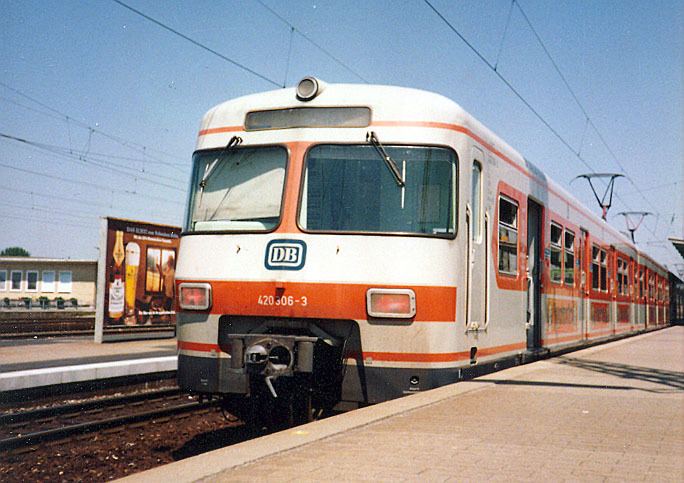Power type Electric Total produced 480 units UIC class 420/421 | Build date 1969 - 1997 AAR wheel arr. Bo'Bo'+Bo'Bo'+Bo'Bo' | |
 | ||
Builder MAN, WMD, LHB, MBB,
O&K, DUEWAG, WU | ||
The Baureihe 420 is a light-weight commuter electric multiple unit developed for the S-Bahn networks in Germany and was originally commissioned by the Deutsche Bundesbahn for the Munich S-Bahn, Stuttgart S-Bahn and Frankfurt S-Bahn networks. It could seat 194 second class, 17 or 33 first class, depending on series. The pivot distance was 16.5 m (54 ft) in cab cars and 14 m (46 ft) in trailer, with a floor height of about 1 m (39.37 in). It ran at 15 kV, 16⅔ Hz, with a tractive effort speed of 72 km/h (20 m/s; 45 mph) and acceleration of 0.9 m/s2 (3.0 ft/s2) or 2.0 mph/s (3.2 km/(h·s)).
Contents
History
It was built from 1969 onwards in several series, later changing the construction from steel to aluminium, making the cars more lightweight and able to carry a greater payload.
It has largely been replaced in said cities by its successor, the Class 423, but some units have been shipped to Stockholm and some have been transferred to the Rhine-Ruhr S-Bahn network. In Sweden the fifteen units received designation X420 serving on the Stockholm commuter rail, and were in service from 2003 until the arrival of the first new X60-series in 2005.
Today's service
Additionally, in the network of Frankfurt S-Bahn, all units of the class 420 have been retired in November 2014 and replaced by the new class 430. Remaining services are some weekday services on the S2 between Dachau and Altomünster of the Munich S-Bahn, some additional peak hour services on several lines of the Stuttgart S-Bahn. Additionally, several units are in operation on some rush-hour services of the Rhine-Ruhr S-Bahn around Düsseldorf since December 2014 and also Cologne since December 2015. Today, all trains of this class have been repainted in the DB-typical "traffic red" (verkehrsrot).
Two 420/421 units in Stuttgart were rebuilt by the ET 420 Plus project, adding air conditioning and passenger information displays to the trains among other things. The aim of this project was to demonstrate a less expensive alternative to new trains in order of keeping the S-Bahn fleet up to date. However, as the new long-term carrier contract with Stuttgart Region includes the acquisition of 83 new class 430 EMUs, all 420s will be withdrawn from service in Stuttgart by 2016.
Preserved Units
These trains were preserved at various museums.
Incidents
A 420 train collided with a freight train at Olching in 1972, causing some light injuries. Two 420 trains collided in the Rüsselsheim train disaster of 1990, leading to 17 dead and 145 injured persons.
